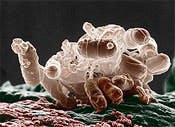A testing program organized by the University of New Hampshire and the University of Massachusetts will use "DNA fingerprinting" to determine what species of mammals or birds are contributing to the pollution of the Souhegan and Merrimack rivers, The Telegraph (New Jersey) reported.
These rivers have been plagued by high levels of E. coli for years. By discovering the primary contributing sources of this contamination, officials may be able to figure out how to combat the high bacteria levels.
For eight years, volunteers have been testing E. coli numbers during the summer at 31 points along the Souhegan and Merrimack rivers.
Often, the highest concentrations have been found at a canoe-launching post on the Souhegan River near Souhegan High School. This post is a popular swimming hole, especially for the high school students.
Though E. coli levels are exceedingly high in this area, there are no obvious sources of runoff from fertilized fields, nor are there large concentration of geese or ducks nearby. There also doesn’t appear to be any sewage entering the river in the area, The Telegraph reported.
DNA fingerprinting should be able to help hunt down the cause of pollutants by figuring out what species is producing them.
"Is it coming from beavers? Is it coming from horses? Is it coming from humans?" George May, an overseer of a volunteer program that checks the waters, told The Telegraph. "Knowing that will be the next step . . . in deciding what to do."
Source: The Telegraph (New Jersey)


